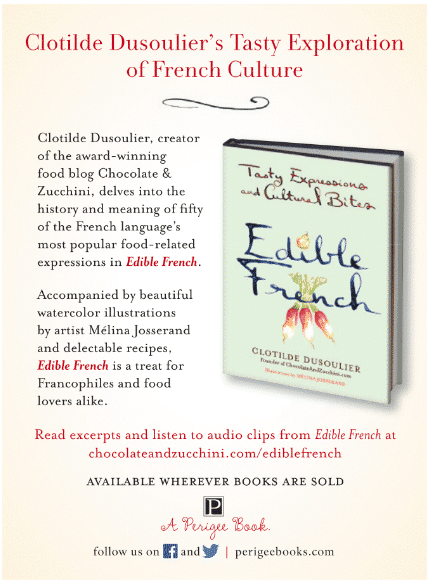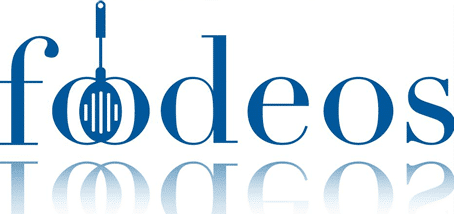Edible French: From Blog to Friendship to Book
Ours is the story of how two French women, living different lives in separate countries, united their skills into a book that would not exist without one or the other. It is a story of passion, patience, and trust, and since we have been fortunate to enjoy a uniquely smooth collaboration, we would like to share, in hindsight, some of the key ingredients that made it possible.
Clotilde Dusoulier is a Parisian food writer and the author of Chocolate & Zucchini, an award-winning food blog she created in 2003. The blog’s popularity led her to swap her software engineering job for a full-time writing career ten years ago, and she has not looked back since. She has published four books, edited two more, and bylined almost two hundred articles in magazines internationally. But what makes her happiest, day in, day out, is the uplifting and gratifying connection she has with her blog readers.
Melina Josserand is a French, but London-based, lawyer who’s also a mother of four, a gifted painter, and the author of the blog MelinArt dedicated to her watercolor renditions of food subjects. Her blog both allows her to promote her art and keeps her motivated to create new work as often as life allows.
No technical skill is required to begin a collaboration. Our work sessions were arranged around our professional and family commitments, and our individual blogs became the perfect arena in which to try things out. As with a good recipe, what we each brought to the mix created something wholly new.
Ingredient #1: A collaboration works best if each participant has shown past initiative, gained momentum, and honed skills on his/her own time.
Beyond our blogs and our shared passion for food, our respective biographies contain another similar chapter: both of us lived abroad for a while (Clotilde in the USA, Melina in the USA and the UK), missed our favorite dishes from home, and threw ourselves into cooking in an attempt to recreate them.
“I yearned for the coffee éclairs of my childhood,” says Mélina, “the cheesy gratins, the rich boeuf aux carottes stews and the peppercorn pâtés I’d grown up with. Unfortunately, I was not born with the ‘thin gene’ the world assumes all French women have. And after a lot of cooking, a lot of tasting, and a few children birthed, the time came to do a bit of dieting.”
Instead of trying new recipes, she chose to devote her free time – after the children were asleep – to drawing, painting, and thinking about how best to illustrate these delicious dishes on paper. She started a blog and committed to posting new art regularly to make sure she spent more time at the drawing desk than at the dinner table. And it worked: not only did she lose forty pounds, but she also grew her portfolio and developed an invaluable network of connections.
Clotilde’s way of channeling her passion took a slightly different form: “I devoted so much time and energy to cooking that I sometimes felt a little deflated after the meals, when the dishes had been cleared and the guests were gone. All that was left of the feast was a memory, but I wanted to keep savoring it. Writing allows me to do that: it gives me a way to ponder the pleasures of the table for much longer, and sharing my ideas and inspirations means others can adopt and add to them. This give me a powerful sense of connection only the Internet can create.”
Ingredient #2: Although opposites can definitely attract, a work partner who has had similar life experiences as you often points, in turn, to shared values and a similar mindset.
As many of our most rewarding encounters have in recent years, our meeting happened online, in 2012, through our respective blogs. Clotilde, who’s long been a lover of languages as well as food, had been running a series of posts on her blog, Chocolate & Zucchini featuring French expressions related to cooking. Melina, whose own interest in culinary matters had brought her to C&Z years earlier, volunteered to provide watercolor illustrations for them. She was constantly seeking new ways to gain exposure for her art, and this seemed like the perfect way to reach an audience who would appreciate her unique portrayals of food.
Clotilde was flattered by the offer, and enthused by the thought of adding hand-drawn art to her blog, which had so far been illustrated by her own photography only. She went to Melina’s blog to view her portfolio and was so taken with her whimsical style and juicy use of color that she said yes immediately, knowing it would make her “edible idioms,” as she dubbed them, come to life much more strikingly.
Ingredient #3: Finding a low-risk project on which to collaborate eases you into the partnership and helps you evaluate how well you work together – how responsive each of you is, how fluidly you communicate, how good you are with deadlines, etc.
But the idea did not stop there. Clotilde explains, “I had been thinking for some time about turning this popular series of idioms into a book, but the puzzle was missing the visual piece. My intent was never to write a texty academic volume, but rather a fun and lovable book that would teach something about French language and French culture while entertaining and delighting the reader. Melina’s unique illustrations were clearly the key to achieving that.”
This confirmed a lesson Clotilde has verified again and again over more than eleven years of blogging: good things come to those who wait. For creative-minded people, the challenge is not finding good ideas, it’s finding the time and resources to bring them to fruition. And while some ideas are meant to be pursued actively, others do much better waiting on the back burner until a spark ignites them – days, months or even years after they first popped into your head. It may be a different angle revealed, a freshly acquired skill – or, in this case, a new person you meet – but it’s up to you to identify it when it appears.
Melina welcomed the idea with equal enthusiasm, and together we plotted what the book might look like: each expression would get a double spread, with Clotilde’s colorful explanation on one side, and Melina’s evocative illustration on the other. It took a year to put together the book proposal and find a publisher through Clotilde’s literary agent, and another year to write and produce the book.
Ingredient #4: Each party should bring value to the relationship with complementary contributions. Our book would not have found a publishing home without both Melina’s eye-catching illustrations and Clotilde’s past bookwriting experiences.
There was a lot of back-and-forth in the process, of course: countless email exchanges and Skype conversations across the Channel, plus a few real-life cups of coffee when Melina had the opportunity to visit her family in Paris.
And this is how we came to agree on the list of food expressions to feature, weighing with equal care their linguistic interest and their artistic potential, and discussing how best to illustrate each. The process was smooth as silk, as each of us deferred to the other’s expertise in her own field, and genuinely admired and respected each other’s work.
Ingredient #5: Keep in mind at all times what each person’s role is and why he was brought in on the project. Let that person have the last word on his own domain.
In October of 2014, our baby was born: released by Perigee Books, an imprint of Penguin Random House. Edible French: Tasty Expressions and Cultural Bites explores fifty of the most intriguing French expressions related to matters of the table.
Indeed, the French language is rife with them, which is really no wonder when you consider the importance of food in French culture. If you are happy, you are said to “have the peach” (avoir la pêche). When someone is getting angry, he has “mustard rising to his nose” (la moutarde lui monte au nez). And having no room to move around is described as being “huddled together like canned sardines” (serrés comme des sardines en boîte).
We are both excited to see our project come to life, and are thrilled with our readers’ reaction and feedback so far. But more important, this publishing adventure has brought us closer, and it is as friends rather than co-authors that we delight in this accomplishment.
Ingredient #6: Value the relationship over the collaboration. Should things become tense or the ride get bumpy, don’t allow difficulties to wedge themselves between you and your work partner. Not only do you stand a much better chance of overcoming them as a team, but you’ll feel a much better person when all is said and done and you are friends still.
Melina’s next project is to write an illustrated book based on life’s milestones as seen through food.
Clotilde keeps busy with her blog, her magazine contributions, her consulting work, her young son, and two new cookbook ideas she’s currently developing. ![]()


